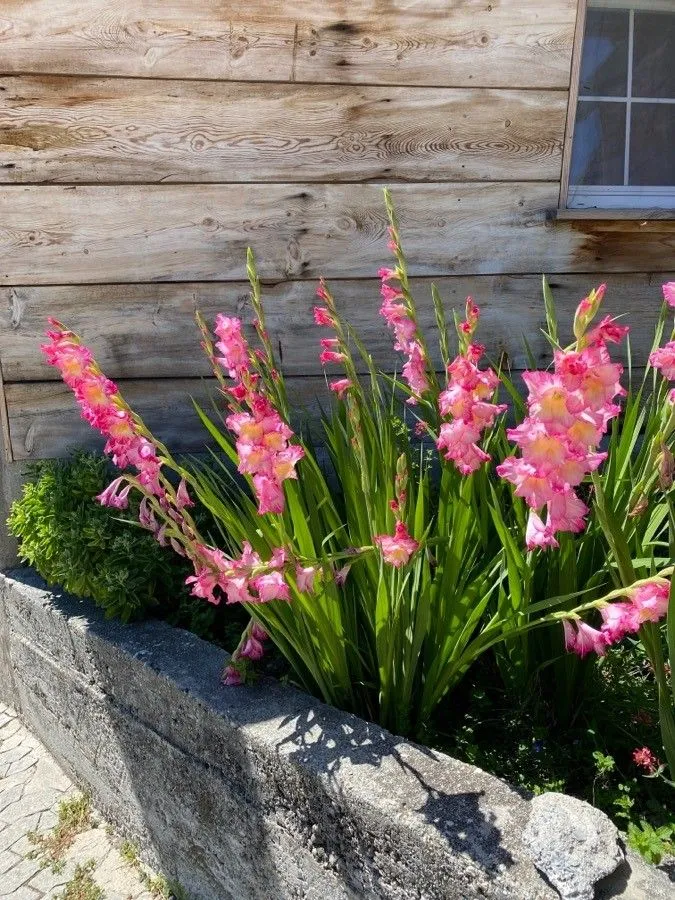
Author: L.
Bibliography: Sp. Pl.: 36 (1753)
Year: 1753
Status: accepted
Rank: species
Genus: Gladiolus
Vegetable: False
Observations: W. & C. Medit., Krym, Caucasus
The Eastern gladiolus, botanically known as Gladiolus communis, is a member of the Iridaceae family. Described initially by the renowned botanist Carl Linnaeus in his seminal work “Species Plantarum” in 1753, this species has captivated the interest of horticulturists and botanists for centuries.
Gladiolus communis is native to diverse regions including Western and Central Mediterranean areas, the Crimean Peninsula, and the Caucasus. This geographic distribution contributes to its varied adaptability and resilience in different climates and soil types. The plant thrives in well-drained soil and sunny locations, with a preference for environments that mimic its native habitat.
The Eastern gladiolus is celebrated for its striking, sword-shaped leaves and tall, graceful spikes adorned with trumpet-shaped flowers. The blossoms of Gladiolus communis exhibit a rich palette of colors, typically ranging from deep purples to delicate pinks, which makes it a popular choice for ornamental gardening and floral arrangements.
This perennial plant plays an essential role in ecological settings, providing nectar for a variety of pollinators, including bees and butterflies. Its robust growth and blooming cycle add visual interest and ecological benefits to gardens and natural landscapes alike.
In horticulture, the Eastern gladiolus is often cultivated for its aesthetic appeal. Gardeners appreciate its relatively low maintenance requirements and its ability to flourish in Mediterranean-like climates outside its native range. Propagation generally occurs through corms, which should be planted in the spring to ensure summer blooms.
Whether admired in a garden or studied in its natural habitat, Gladiolus communis demonstrates the elegance and resilience of the flora from which it originates. Its long-standing place in botanical literature underscores its enduring significance in both scientific and ornamental contexts.
Eng: cornflag, eastern gladiolus
Deu: garten-siegwurz, gewöhnliche siegwurz
Dan: gladiolus, jomfrufinger
Swe: småblommig sabellilja
Cym: blodyn-y-cleddyf dwyreiniol
Lat: gladiolus
En: Eastern gladiolus, Cornflag, Common Gladiolus
Da: Gladiolus, Jomfrufinger
Fr: Glaïeul commun
De: Garten-Siegwurz, Gewöhnliche Siegwurz, Garten-Gladiole
It: Gladiolo maggiore
La: Gladiolus
Sv: Småblommig sabellilja
Cy: Blodyn-y-Cleddyf Dwyreiniol
Taken Jul 19, 2021 by jacques poutru (cc-by-sa)
Taken Jul 5, 2021 by Manuëlle (cc-by-sa)
Taken May 12, 2017 by Olivier Le Gall (cc-by-sa)
Taken Jul 12, 2018 by plastronixx (cc-by-sa)
Taken Jul 19, 2021 by jacques poutru (cc-by-sa)
Taken May 23, 2015 by Tela Botanica − David MERCIER (cc-by-sa)
Taken May 17, 2022 by James Cronin (cc-by-sa)
Taken Jul 15, 2022 by Dave Flack (cc-by-sa)
Taken Jul 15, 2022 by Dave Flack (cc-by-sa)
Taken Jul 5, 2021 by Manuëlle (cc-by-sa)
Taken Jan 1, 1900 by EOL − Encyclopedia of Life (cc-by-nc-sa)
Taken Oct 24, 2021 by Trap Hers (cc-by-sa)
Taken Sep 3, 2021 by Landschaftsgärtner (cc-by-sa)
Taken Jan 1, 1900 by EOL − Encyclopedia of Life (cc-by-nc-sa)
Taken Jul 29, 2021 by Jacques Zuber (cc-by-sa)
Taken Feb 22, 2022 by Marko Kjuder (cc-by-sa)
Taken Aug 29, 2021 by Annemarie Ahrens-Stehle (cc-by-sa)
Taken Aug 7, 2021 by William Coville (cc-by-sa)
Taken Jun 11, 2022 by Estelle Vava (cc-by-sa)
Taken Jul 29, 2021 by Jacques Zuber (cc-by-sa)
Taken Jul 8, 2022 by Karine Castel (cc-by-sa)
Taken Jul 12, 2020 by Željko Kalaković (cc-by-sa)
Taken Jul 8, 2021 by Sabin Poenariu (cc-by-sa)
Taken Apr 4, 2021 by Monteiro Henrique (cc-by-sa)
Taken Jun 19, 2017 by Tela Botanica − Florent BECK (cc-by-sa)
Taken Aug 25, 2022 by eva n. (cc-by-sa)
Taken Jun 19, 2017 by Tela Botanica − Florent BECK (cc-by-sa)
Taken Jun 19, 2017 by Tela Botanica − Florent BECK (cc-by-sa)
Taken Jun 19, 2017 by Tela Botanica − Florent BECK (cc-by-sa)
© copyright of the Board of Trustees of the Royal Botanic Gardens, Kew.
© copyright of the Board of Trustees of the Royal Botanic Gardens, Kew.
© copyright of the Board of Trustees of the Royal Botanic Gardens, Kew.
Growth habit>: Forb/herb
Ph maximum: 8.0
Ph minimum: 7.5
Light: 8
Atmospheric humidity: 7
Bloom months: [‘may’, ‘jun’]
Soil nutriments: 2
Family: Myrtaceae Author: (F.Muell.) K.D.Hill & L.A.S.Johnson Bibliography: Telopea 6: 402 (1995) Year: 1995 Status:…
Family: Rubiaceae Author: Pierre ex A.Froehner Bibliography: Notizbl. Bot. Gart. Berlin-Dahlem 1: 237 (1897) Year:…
Family: Sapindaceae Author: Koidz. Bibliography: J. Coll. Sci. Imp. Univ. Tokyo 32(1): 38 (1911) Year:…
Family: Asteraceae Author: A.Gray Bibliography: Pacif. Railr. Rep.: 107 (1857) Year: 1857 Status: accepted Rank:…
Family: Fabaceae Author: Medik. Bibliography: Vorles. Churpfälz. Phys.-Ökon. Ges. 2: 398 (1787) Year: 1787 Status:…
Family: Aspleniaceae Author: (Cav.) Alston Bibliography: Bull. Misc. Inform. Kew 1932: 309 (1932) Year: 1932…